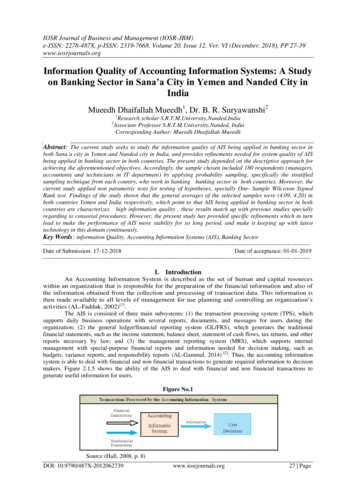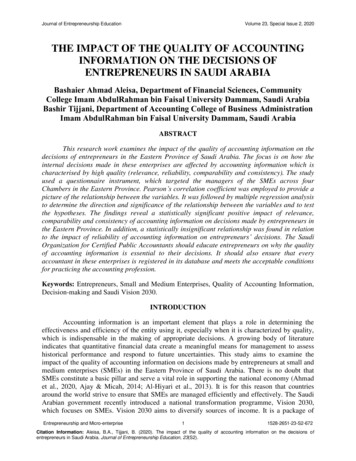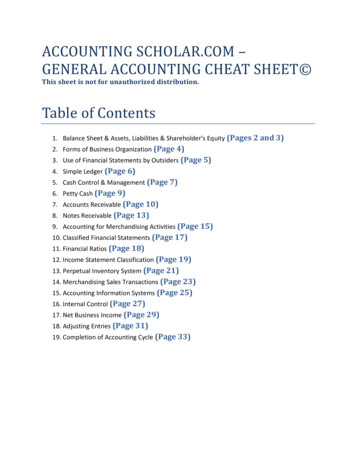
Transcription
IOSR Journal of Business and Management (IOSR-JBM)e-ISSN: 2278-487X, p-ISSN: 2319-7668. Volume 20, Issue 12. Ver. VI (December. 2018), PP 27-39www.iosrjournals.orgInformation Quality of Accounting Information Systems: A Studyon Banking Sector in Sana’a City in Yemen and Nanded City inIndiaMueedh Dhaifallah Mueedh1, Dr. B. R. Suryawanshi21Research scholar S.R.T.M.University,Nanded,IndiaAssociate Professor S.R.T.M.University,Nanded, IndiaCorresponding Author: Mueedh Dhaifallah Mueedh2Abstract: The current study seeks to study the information quality of AIS being applied in banking sector inboth Sana’a city in Yemen and Nanded city in India, and provides refinements needed for system quality of AISbeing applied in banking sector in both countries. The present study depended on the descriptive approach forachieving the aforementioned objectives. Accordingly, the sample chosen included 180 respondents (managers,accountants and technicians in IT department) by applying probability sampling, specifically the stratifiedsampling technique from each country, who work in banking banking sector in both countries. Moreover, thecurrent study applied non parametric tests for testing of hypotheses, specially One- Sample Wilcoxon SignedRank test. Findings of the study shown that the general averages of the selected samples were (4.09, 4.20) inboth countries Yemen and India respectively, which point to that AIS being applied in banking sector in bothcountries are characterizes high information quality , these results match up with previous studies speciallyregarding to censorial procedures. However, the present study has provided specific refinements which in turnlead to make the performance of AIS more stability for so long period, and make it keeping up with latesttechnology in this domain continuously.Key Words: information Quality, Accounting Information Systems (AIS), Banking ------------------------------- --------Date of Submission: 17-12-2018Date of acceptance: ----------------------------------- ---------I. IntroductionAn Accounting Information System is described as the set of human and capital resourceswithin an organization that is responsible for the preparation of the financial information and also ofthe information obtained from the collection and processing of transaction data. This information isthen made available to all levels of management for use planning and controlling an organization’sactivities (AL-Faddak, 2002)[1].The AIS is consisted of three main subsystems: (1) the transaction processing system (TPS), whichsupports daily business operations with several reports, documents, and messages for users during theorganization; (2) the general ledger/financial reporting system (GL/FRS), which generates the traditionalfinancial statements, such as the income statement, balance sheet, statement of cash flows, tax returns, and otherreports necessary by law; and (3) the management reporting system (MRS), which supports internalmanagement with special-purpose financial reports and information needed for decision making, such asbudgets, variance reports, and responsibility reports (AL-Gammal, 2014) [2]. Thus, the accounting informationsystem is able to deal with financial and non financial transactions to generate required information to decisionmakers. Figure 2.1.5 shows the ability of the AIS to deal with financial and non financial transactions togenerate useful information for users.Figure No.1Source (Hall, 2008, p. 8)DOI: 10.9790/487X-2012062739www.iosrjournals.org27 Page
Information Quality of Accounting Information Systems: A Study on Banking Sector in Sana’a City .1.1 Accounting Information QualitiesThe quality of information is considered the basic component that make information useful, then it isthe crucial objective that should be sought when accounting information system is made. The utility ofinformation must be assessed in relation to the purpose can be achieved, and the objectives of financial reportsare focused on the use of accounting information in decision making. Accounting choices must be judged on thelight of cost considerations, which make information most useful for decision making (AL-Isaqqa, 2003) [3].Figure No.2A Hierarchy of Accounting CharacteristicsSource (AL-Mejhaly, 2009): [4]As per the above figure, the qualitative characteristics of accounting information system as had beenclassified by Financial Accounting Standards Board (FASB) are as follows:1.2.1Basic characteristics of information:These features are presented in the following characteristics:1.2.1.1 Benefit/cost:It is important to observe that desired accounting information characteristics must be subjected tobenefit/cost principle, which means that each particularity of accounting information characteristics representsan additional cost of the system, so it is necessary that potential benefit of each characteristic must exceed theneeded cost to obtain it (AL-Rawy, 1999) [5].1.2.1.2 Understandability:Information is understandable when is produced in a useful and intelligible format (AL-Shirazy,1990)[6]. Understandability enables users to grasp the significance of information. Valued from theuser’s point of view, understandable information is provided in a form that allows its application bythe user in the decision-making situation at hand. For example, information must be presented in alanguage that is easily understood by the decision maker. By language, it means that native language,such as English or French, as well as technical language, such as those used in physics or computerscience. Also, information that makes excessive use of codes and acronyms may not beunderstandable to some decision makers (Al-Hassany, 1998) [7].1.2.2Primary Qualitative Characteristics of Accounting Information:1.2.2.1 Relevance.Relevance has been pinpointed as pertaining to or having a bearing on the matter in question. It meansinformation’s ability to make a difference. For investors, creditors and others the information should be relevant,DOI: 10.9790/487X-2012062739www.iosrjournals.org28 Page
Information Quality of Accounting Information Systems: A Study on Banking Sector in Sana’a City .and capable of making differences in a decision by helping users to prepare productions about the outcomes ofpresent and future events or to confirm or correct expectations. Information may confirm expectation or maychange them. If it conform them, it augments the probability that the results will be as previously expected. If itchanges them, it changes the perceived probability of the previous possible outcomes (Dahmash, 1995) [8].1.2.2.1.1Timeliness:It is affiliated aspect of relevance. If information is not available when it is demanded or becomesavailable only after reported event that it loses its value for future actions, it lacks relevance. Timeliness inpresent context means having information available to decision makers before it loses its importance for users,through obsolescence or be out-of- date, and then becomes less influence decision maker. Timeliness isolatedcannot make information relevant. However, a lack of timeliness can prevent information of relevance. It mightotherwise have interested (FASB, 1993) [9].1.2.2.1.2Predictive Value of Information:Predictive value plays a core role in improving the decision maker’s ability on prediction offuture events, by familiarity with events of the past and future, which means that prediction processrelies on past and present events. For example, when the manager of a company estimates the volumeof production and the size of the stock on the basis of expectations of the volume of sales in thefollowing periods is considered good example of that predictive process of the information (FASB I.A., 2008)[10].1.2.2.1.3 Feedback value:According to (FASB, 1993), feedback value of accounting information means that informationenables users confirming or correcting prior expectation. The feedback value of the information comes from theability of the resulted information from the decision-making to confirm the outcomes of those decisions as wellas help in making other decisions (Hajar, 2014) [11].1.2.2.2 ReliabilityThe reliabilty is quality of information that assures that information is reasnobly free from bias anderrors and faithfully represnts what it purports to represent . Reliability means that information must be freefrom error or bias and accurately represents the events or activities of the organisation (Hall, 2008) [12].Reliability relates to the provision of appropriate information for management to pursue its functions duly(Romney, 2014) [13]. Reliability is one of the primary qualitative properties of information. This property isavialable when information is free from bias and errors and possesses representational faithfullness that meansit is related to honesty of accounting information and possesses potentiality to dependability on it (Romny,2015) [14].1.2.2.2.1 Representational Faithfulness:Representational faithfulness can be described as correspondence or agreement between adescription or measure and phenomenon it claims to represent. In accounting phenomena to berepresented are economic resources and obligations and the transactions and events that affect thoseresources and obligations (FASB, 2008)[15].1.2.2.2.2 Neutrality:Neutrality means not showing information for the purpose of inducing or influencing aparticular part of the users of the financial statements or showing financial statements to serve aparticular user on account of another user (Yossif, 1985) [16]. According to (AL-Rawy, 1999)neutralityrefers to that, accounting information should not be biased to certain side of users of financialstatements, without another party of users of financial reports. In general, the neutrality of information isimplied avoiding intended actions of bias, which may be practiced by preparers of financial statements(Wheeler, 2012) [17].1.2.2.2.3 Verifiability:The characteristic of verifiability participates in the utilization of accounting informationbecause the purpose of verification is to provide a significant degree of confirming accountingmeasures that represent what they purport to represent. Verification is in this sense, moresuccessful in minimizing measurer bias than measurement bias, and thus it participates in varyingdegrees toward affirming that particular measures represent faithfully the events or economicthings that they purport to represent. Verification contributes either little or nothing towardDOI: 10.9790/487X-2012062739www.iosrjournals.org29 Page
Information Quality of Accounting Information Systems: A Study on Banking Sector in Sana’a City .assertion that measures used are relevant to the decision for which the information is intended tobe beneficial. Verification means unanimity (FASB I. A., 2008) [18].1.2.3Secondary Qualitative Characteristics of Accounting Information:1.2.3.1 Consistency Property:Consistency principle means that, an organization applies accounting ways and methods tomeasure accounting economic events from accounting period to another [19]. It means continuity in usethe accounting methods, which are used to measure and communicate of accounting information fromaccounting period to another, and in the case of, occurring any changes, must be disclosed bypreparers of the financial statements to be taken into consideration by users [20].1.2.3.2 ComparabilityComparability means that accounting information has ability to be compared with othersimilar accounting information during specific financial period, either in the same economic unit orwith others similar economic units [21].1.2.3.3 Completeness:This property aims to make all information of specific item available, this can be achieved through theability of accounting information system to process all transactions related to that item, and then providingrelevant and reliable information influences accounting entity. So if any part of those transactions is missing, theinformation will be incomplete [22]. The completeness characteristic means that, all necessary information shouldbe available for users [23]. As (Yossif, 1985). indicated that accounting information should be relevant to allactivities related to each other, and be provided in form of relevant financial reports lead to increase theeffectiveness of the system.1.2.3.4 Materiality:Materiality is a prevalent concept that is related to the qualitative characteristics, especially reliabilityand relevance. Materiality and relevance are both defined in terms of what influences which make a difference to adecision maker, but the two terms can be recognized. A decision is not to disclose certain information that may bemade, said, because investors have no desire for that kind of information (it is not relevant) or because the size involvedis too small to make a difference (they are not material). Magnitude by itself, without regard to the nature of the itemand the circumstances in which the judgment has to be made, will not be generally enough bases for a materialityjudgment. The Board’s present position is that no general standards of materiality can be made to take into considerationall the considerations that enter into an experienced human judgment. Quantitative materiality criteria may be given bythe Board in specific standards in the future, as in the past, as appropriate [24].1.2Statement of the Problem:The researcher seeks to analysis information quality of Accounting Information Systems being appliedin Banking Sector in Sana’a City in Yemen and Nanded City in India. Thus, the problem of the study has beenpresented in the form of two questions. The first one is: what is the current information quality of the AIS beingapplied in banking sector in both Sana’a ci
1.1 Accounting Information Qualities The quality of information is considered the basic component that make information useful, then it is the crucial objective that should be sought when accounting information system is made. The utility of information must be assessed in relation to the purpose can be achieved, and the objectives of financial reports are focused on the use of accounting .











